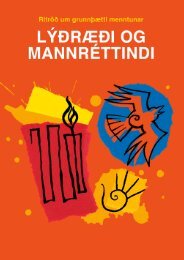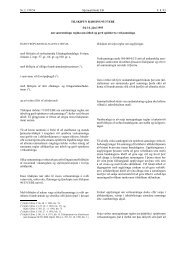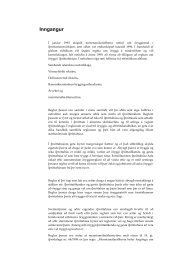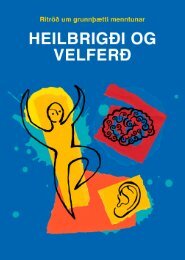Arts and Cultural Education in Iceland : Professor Anne Bamford
Arts and Cultural Education in Iceland : Professor Anne Bamford
Arts and Cultural Education in Iceland : Professor Anne Bamford
Create successful ePaper yourself
Turn your PDF publications into a flip-book with our unique Google optimized e-Paper software.
music sector could be less constra<strong>in</strong>ed by curriculum <strong>and</strong> timetables, have more expertise <strong>and</strong><br />
smaller class sizes <strong>and</strong> so may be better resourced to engage <strong>in</strong> more cutt<strong>in</strong>g edge practice <strong>and</strong><br />
risk tak<strong>in</strong>g. But the observations conducted <strong>in</strong> this research would suggest that <strong>in</strong> the majority of<br />
case the opposite is true.<br />
Risk tak<strong>in</strong>g seemed to be most prevalent <strong>in</strong> the small, voluntary <strong>and</strong> <strong>in</strong>dependent arts <strong>and</strong><br />
cultural sector. Major cultural agencies reported that <strong>in</strong> the last year they had become less<br />
‘risky’ as they were <strong>in</strong>creas<strong>in</strong>gly hav<strong>in</strong>g to fully economic cost their offer<strong>in</strong>gs so ‘safe’ options<br />
were seen to be better than more experimental work that may not produce a cash surplus.<br />
3.6 Flexible organizational structures <strong>and</strong> permeable boundaries<br />
‣ Schools <strong>and</strong> cultural <strong>in</strong>stitutions have developed <strong>in</strong>novative ways to encourage more<br />
permeable boundaries around their organisations <strong>and</strong> more flexibility with<strong>in</strong> the<br />
organisation<br />
‣ Music Schools should consider becom<strong>in</strong>g more flexible <strong>in</strong> response to societal <strong>and</strong><br />
economic changes<br />
In general it was acknowledged that the arts provided a valuable opportunity for pupils to go<br />
beyond their direct environment <strong>and</strong> to be more creative <strong>and</strong> to exp<strong>and</strong> their horizons. In a<br />
number of examples visited, the presence of greater <strong>in</strong>volvement of parents <strong>and</strong> the community<br />
had meant that the school had taken on a fuller life with<strong>in</strong> the town <strong>and</strong> was be<strong>in</strong>g recognised<br />
for its <strong>in</strong>novative practice.<br />
Conversely, <strong>in</strong> the after school provisions the general aim appeared to be to make the pupils<br />
skilled <strong>in</strong> the status quo <strong>and</strong> so did not provide opportunities for creative expression or risk<br />
tak<strong>in</strong>g. It could be argued, though, that specialist sett<strong>in</strong>gs did encourage pupils to progress<br />
beyond the perceived scope of their personal skills or talents. This was certa<strong>in</strong>ly true <strong>in</strong> some<br />
<strong>in</strong>stances, but also as there was a very high drop out rate <strong>in</strong> these sett<strong>in</strong>gs, it appeared that<br />
many pupils left just at the po<strong>in</strong>t where their personal art mak<strong>in</strong>g might be stretched, extended<br />
or challenged. This was particularly the case <strong>in</strong> music, where the enforcement of music theory or<br />
the lack of skilled teachers led to high drop out rates <strong>in</strong> early adolescence.<br />
Quality arts programmes flourish <strong>in</strong> situations where there is scope for organizational<br />
flexibility. In several schools visited there was a strong sense of connectivity. This was used as a<br />
strategy to enhance learn<strong>in</strong>g <strong>and</strong> to achieve multiple aims through the same <strong>in</strong>put. In a general<br />
sense, Icel<strong>and</strong>ic schools are very open. As members of a research team it was relatively easy to<br />
ga<strong>in</strong> access to schools <strong>and</strong> we were greeted with genu<strong>in</strong>e warmth <strong>and</strong> given access to teachers<br />
<strong>and</strong> classrooms. Similarly, parents are generally very welcome, though ma<strong>in</strong>ly as audience<br />
members dur<strong>in</strong>g special performances. Children are given considerable respect <strong>and</strong> freedom <strong>and</strong><br />
the children appear responsible <strong>and</strong> confident.<br />
While <strong>in</strong>ternationally schools historically are not known for their flexibility <strong>and</strong> adaptability,<br />
it has to be said that the same criticism could be levelled at galleries, museums <strong>and</strong> cultural<br />
<strong>in</strong>stitutions. As the tradition of many of these is from an elitist history <strong>and</strong> a position of privilege<br />
with<strong>in</strong> society, it is not surpris<strong>in</strong>g that people work<strong>in</strong>g to make these <strong>in</strong>tuitions more flexible face<br />
a challenge.<br />
This criticism was particularly levelled at music schools. These music schools have a long <strong>and</strong><br />
illustrious history <strong>in</strong> Icel<strong>and</strong> <strong>and</strong> are highly valued by all levels of society. Yet such history has<br />
been generally built on tradition more than adaptability. As society <strong>and</strong> education changes, the<br />
challenge is for the music school sector to respond to these changes <strong>in</strong> a reflective way. There<br />
73



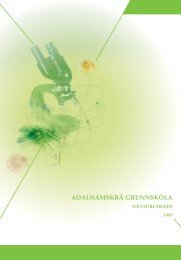
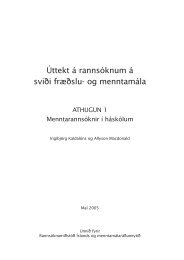

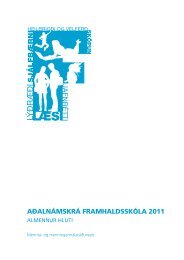
![Aðalnámskrá tónlistarskóla : rytmÃsk tónlist [Eingöngu á rafrænu formi]](https://img.yumpu.com/50843672/1/184x260/aaalnamskra-tanlistarskala-rytma-sk-tanlist-eingangu-a-rafranu-formi.jpg?quality=85)
